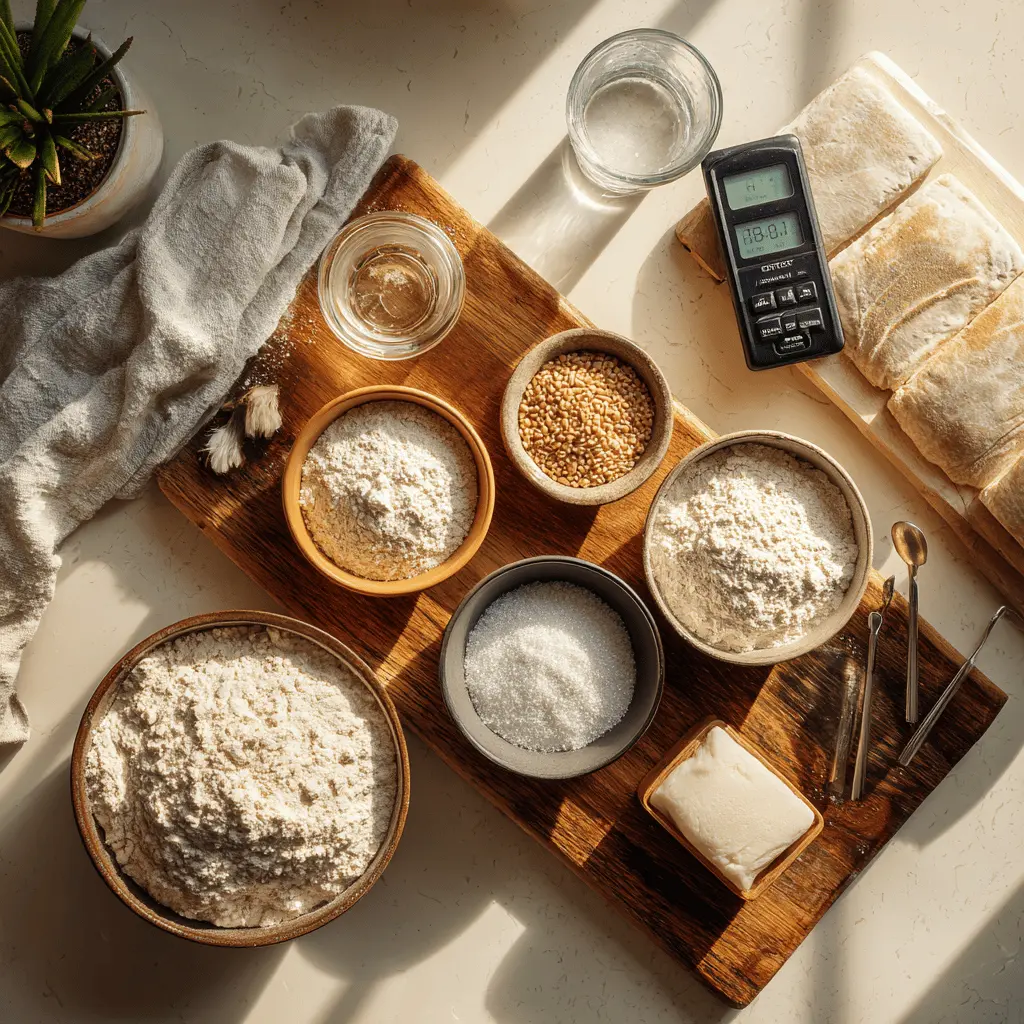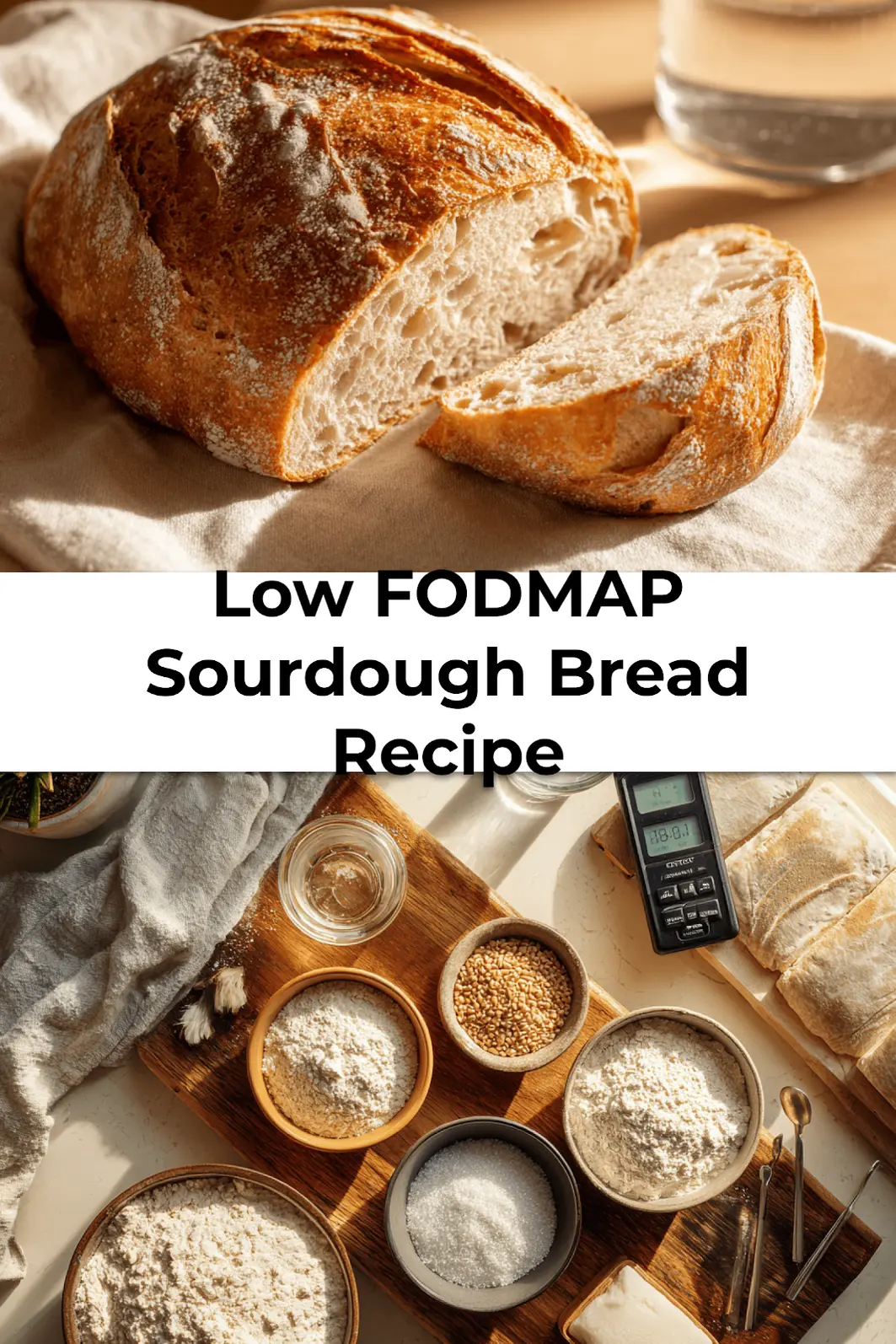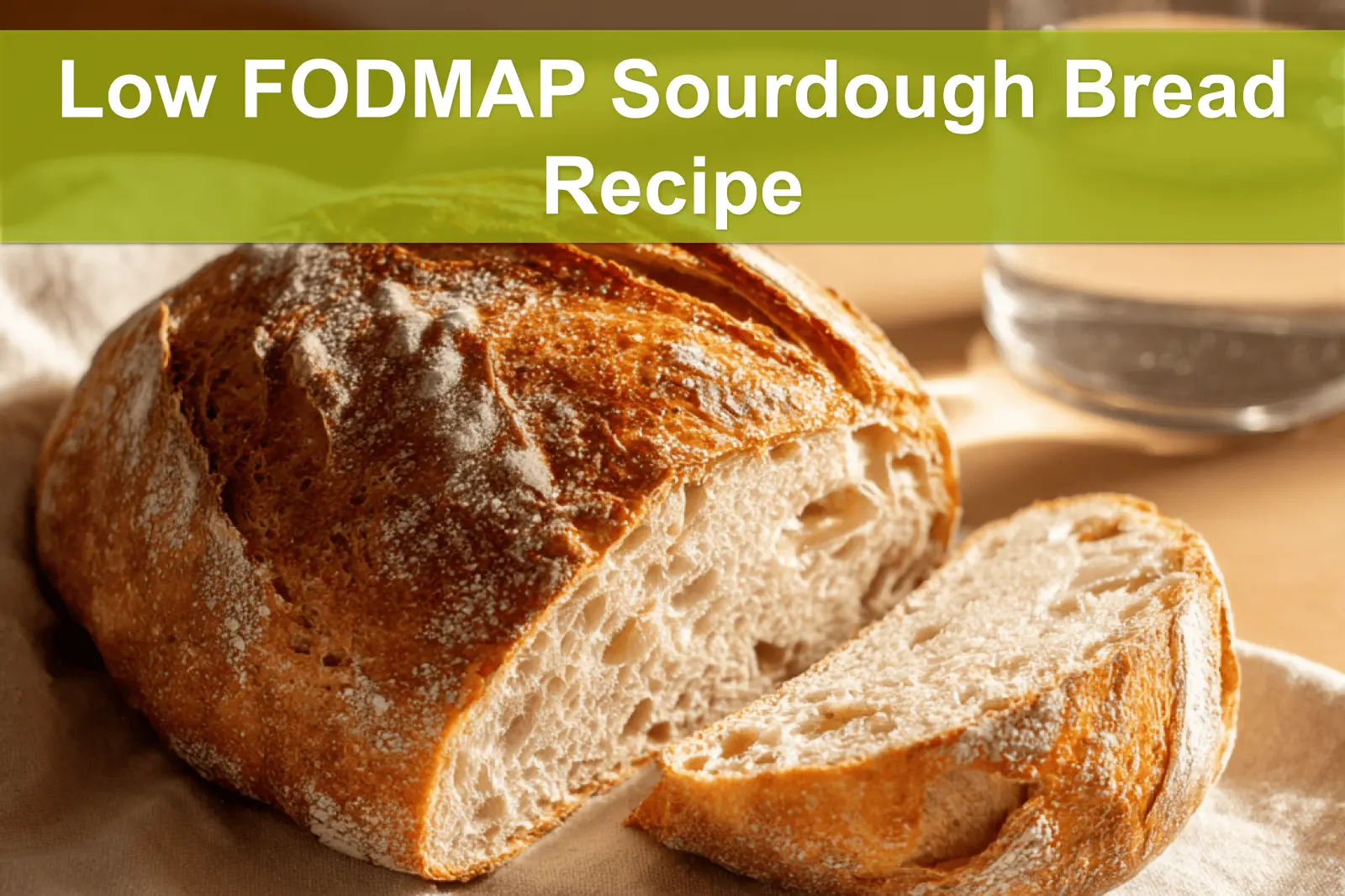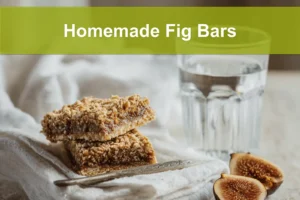Ever notice how the smell of fresh sourdough pulls you right back to a cozy kitchen, sunlight hitting the counter just right? This Low FODMAP Sourdough Bread Recipe delivers that same magic—but with a gentle touch for sensitive stomachs. It’s been buzzing around Pinterest lately, becoming a favorite for folks longing to enjoy bread again without digestive discomfort. I tested it many times (messy apron and all)—no fancy gear required, just time, care, and a happy starter. The crust crackles, the soft interior practically melts in your mouth, and your kitchen? It’ll smell like a warm hug.
This isn’t just any sourdough bread—it’s made lighter and easier on digestion. With just flour, water, sourdough starter, and salt, it keeps things simple and pantry-friendly. There’s no fuss or strange ingredients. Think of it as grandma’s loaf, only with that modern low FODMAP twist. Full details are right here in the blog!
Sourdough was actually the first thing I learned to bake—standing on a step stool, flour on my nose, my grandma’s hands guiding mine. She didn’t know about FODMAPs, but I sure wish she could taste this one. It took plenty of trial and error to get that crusty-on-the-outside, tender-inside loaf that’s kind to the gut. No gimmicks, no gluten cheats—just real bread, rooted in tradition, and made with care. And there’s a little trick I use with the proofing bowl that makes all the difference—tested, approved, and ready for your kitchen.
Why You’ll Love This Recipe
If bread has ever felt like a guilty pleasure for your stomach, this Low FODMAP Sourdough Bread might just be your new go-to. Thanks to a slow fermentation and gut-friendly ingredients like spelt and bread flour, it’s designed to be gentle on digestion without compromising on taste or texture. There’s nothing quite as comforting as pulling a golden, homemade loaf from the oven, and this recipe brings all those cozy vibes—with no post-bread regrets.
What I love most about this loaf is its simplicity. No extra steps, no special ingredients—just good ol’ flour, water, starter, and salt. It’s exactly the kind of bread my grandma would’ve made, even if she didn’t know it was Low FODMAP-friendly. With a little trial and error, you’ll soon be baking this one on repeat—and maybe even inventing your own delicious tweaks along the way!
What You’ll Need
Let’s get down to basics. This bread sticks to straightforward ingredients, each one playing an essential role. Bread flour adds strength and structure, providing a lovely rise, while whole grain spelt flour contributes a toasty, nutty flavor and keeps things low FODMAP. You’ll also need filtered water, fine sea salt, and an active sourdough starter—the bubbly backbone of your dough.

Pro Tip: If you’re new to sourdough baking, there’s no need for fancy gadgets. A basic mixing bowl, a wooden spoon, and a standard loaf pan are all you need. For proofing, I sometimes repurpose a glass mixing bowl with a silicone lid—old-school and effective!
Key Tools for Success
- A medium-sized mixing bowl
- A non-stick bread pan or parchment paper
- A wooden spoon or Danish dough whisk
- A marker or rubber band for tracking starter activity
Step-by-Step Process with Tips
The beauty of this recipe is in the slow, manageable rhythm. Start by feeding your sourdough starter several hours (or even the night) before baking—it should be bubbly and doubled in size before use. Once it’s ready, mix your flours, water, salt, and starter to form a shaggy dough before resting.
Pro Tip: Feel uncertain about the stretch and fold process? Don’t stress. These gentle folds develop the dough’s gluten structure naturally over time. It’s okay if the dough is slightly sticky—that’s totally normal for this type of bread.
Timing Table
| Step | Approx. Time |
|---|---|
| Fed Starter Doubling | 4–12 hours |
| Mixing + First Rest | 30 minutes |
| Stretch & Folds | 90 minutes (3 sets) |
| Initial Bulk Fermentation | 5–10 hours |
| Proof in Fridge | 8–12 hours |
| Final Rise (Room Temp) | 1–2 hours |
| Baking | 40 minutes |
Common Troubleshooting Tips
Is your dough overly sticky? That’s quite normal when using spelt flour, which hydrates differently than standard wheat flours. Lightly flour your work surface or hands when shaping, and consider using a metal bench scraper for added control.
If your dough isn’t rising dramatically during bulk fermentation, check your room temperature—it may simply be a bit too cool. A warmer spot (around 75–80°F) helps bump up that rise. If your crust comes out pale, extend the bake time by 5–10 minutes or double-check your oven’s calibration using an oven thermometer.
Serving and Storage Suggestions
This bread is fantastic when toasted and topped with Low FODMAP-friendly spreads like natural peanut butter, grass-fed butter, or a drizzle of extra virgin olive oil. It also pairs beautifully with soups or works perfectly as sandwich bread.
Pro Tip: To stay crisp, store your bread cut-side down on a wooden board or in a breathable bread bag. For longer storage, slice and freeze it—toast slices straight from the freezer or reheat them briefly in the oven for a fresh-baked vibe.
Expert Insight: Baking with Low FODMAP Ingredients
Developing a proper low FODMAP sourdough bread means understanding how time and ingredients work together. That long fermentation process? It helps reduce fermentable sugars by letting lactic acid bacteria work their magic, improving digestibility without sacrificing the classic sourdough tang we all love. Spelt, in moderation, is typically easier on sensitive stomachs than modern wheat—but always test what works for you personally or consult a dietitian.
For more delicious recipes and cooking inspiration, follow me on Facebook, Pinterest and Reddit!
Low FODMAP Sourdough Bread Recipe That Finally Clicked
After countless trials tweaking the ingredients and adjusting fermentation times, I finally landed on the perfect low FODMAP sourdough bread recipe. It took patience (and a few kitchen mishaps—like forgetting to feed the starter!), but this version brings back that comforting texture I first learned while baking with my grandmother. It toasts beautifully, holds up to sandwiches, and doesn’t leave me feeling bloated. A true win!
FAQs ( Low FODMAP Sourdough Bread Recipe )
Is sourdough bread low FODMAP?
Yes, traditional sourdough can be lower in FODMAPs because the long fermentation allows lactic acid bacteria to break down some fermentable carbohydrates. Using a low FODMAP flour blend and extending the ferment time helps reduce FODMAP content further. Individual tolerance still varies, so start with a small serving to test how you react. If you have severe IBS, check with a registered dietitian for personalized advice.
What flours are safe for a Low FODMAP sourdough?
Safe choices often include rice flour, certified gluten-free oat flour, buckwheat flour, and certain low FODMAP commercial gluten-free blends available in the USA. Spelt or sourdough made from wheat may be tolerated by some people in small portions, but they can still be high FODMAP for others. Avoid high FODMAP flours like regular rye and large amounts of whole wheat unless you know you tolerate them. Always check package labels and start with tested servings.
How long should I ferment to reduce FODMAPs?
A longer fermentation generally helps reduce FODMAPs, so aim for a bulk ferment plus a proof that totals 12 to 24 hours, or use an overnight cold retard in the refrigerator. The exact time depends on your starter activity, room temperature, and flour choice, so watch the dough rather than the clock alone. Cold retarding for 12 to 18 hours is a practical method in many home kitchens. Remember that longer fermentation improves digestibility but also changes flavor and texture.
Can I use store-bought sourdough starter?
Yes, you can use a store-bought wild yeast sourdough starter, but check the label to avoid additives or unexpected ingredients. If the starter is dried or from a different flour base, feed and refresh it with your chosen low FODMAP flours for a few cycles so it adapts. Many bakers also prefer to build their own starter from scratch using the recipe flour for best results. Avoid starters that list sugars or preservatives on the ingredient list.
How should I store Low FODMAP sourdough bread to keep it fresh?
Store your sourdough at room temperature in a breathable bag or a cloth-lined basket for 1 to 2 days to keep the crust and crumb in good shape. For longer storage, slice and freeze the bread in airtight freezer bags and thaw slices as needed or toast them straight from frozen. Avoid refrigeration, which makes bread stale faster, unless you plan to use it in recipes. To refresh the crust, pop the loaf into a 350 F oven for 5 to 10 minutes.

Wrapping Up Your Low FODMAP Sourdough Bread Adventure
This Low FODMAP Sourdough Bread Recipe is more than just another recipe—it’s a comforting return to simpler baking. It offers that chewy crumb, crisp crust, and gentler digestibility you’ve been craving. Plus, it’s approachable even on busy days.
Feel free to play around—swap spelt for buckwheat or sprinkle on sunflower or pumpkin seeds for extra texture. To store, wrap in a towel or beeswax wrap at room temperature for a day or two, or freeze slices for quick weekday breakfasts.
And now, I’d love to hear from you. What’s your favorite homemade bread memory—or secret trick? Snap a photo, share your story, and pass this along to another bread lover who might appreciate a loaf that’s both tasty and tummy-friendly. Happy baking!

Low FODMAP Sourdough Bread Recipe for Easy Digestion
Ingredients
Method
- Feeding the Starter: Remove 25 grams of sourdough starter from the fridge. Mix with 25 grams whole grain spelt flour and 25 grams water in a glass jar. Stir well until no dry flour remains. Cover and mark the jar, let sit at room temperature for 4-12 hours until it doubles in size. The First Rise: Once starter has doubled, combine bread flour, whole grain spelt flour, water, salt, and 50 grams active starter in a mixing bowl. Stir until no dry flour remains; add a spoonful of water if dough feels dry. Cover and let rest 30 minutes. Stretch and Folds: Perform first set of stretch and folds by stretching each side (north, south, east, west) over the dough. Rest dough 30 minutes. Repeat stretch and fold two more times with 30-minute rests in between. After third fold, cover and let rise at room temperature until dough doubles in size (5-10 hours). Shaping: When doubled, sprinkle flour and flip dough onto counter. Flip sticky side down, pull edges to form a ball. Rest uncovered for 20-30 minutes. Final shape: Sprinkle flour on top, flip so floured side down, flatten dough into a rectangle. Roll into a log shape and place seam-side down in loaf pan. If pan isn’t non-stick, line with parchment paper. The Second Rise: Cover dough and refrigerate overnight or 8-12 hours to extend fermentation. Remove from fridge and let rise at room temperature until doubled and puffed over pan. Baking: Preheat oven to 450°F 30 minutes before baking and place a metal pan on bottom rack. Place loaf on middle rack and pour a cup of hot water into the bottom pan to create steam. Bake 20 minutes, remove steam pan, reduce oven to 400°F, and bake 15-20 more minutes until the internal temperature reaches 190°F. Cooling: Remove bread from pan and cool on wire rack for at least one hour before slicing.
Notes
- Use King Arthur Bread Flour and Bob’s Red Mill whole grain spelt flour for best results, though any whole grain spelt flour should work. Incorporating a long fridge proofing helps reduce FODMAPs by extending fermentation.














